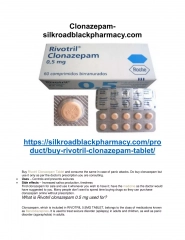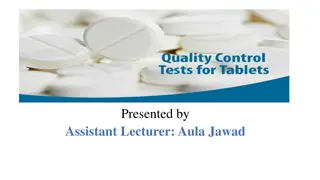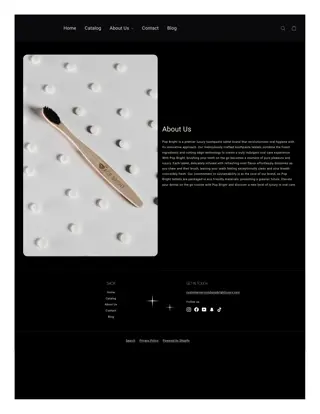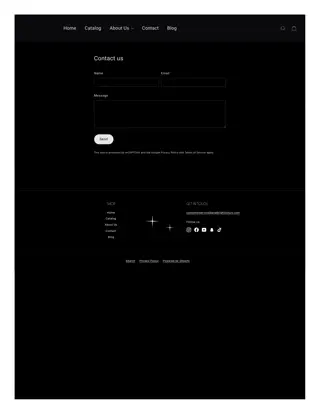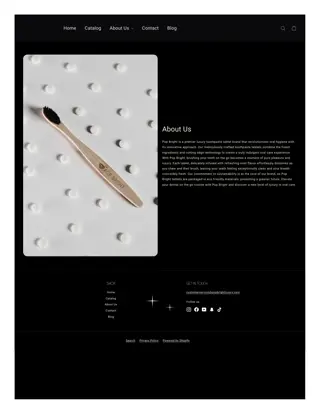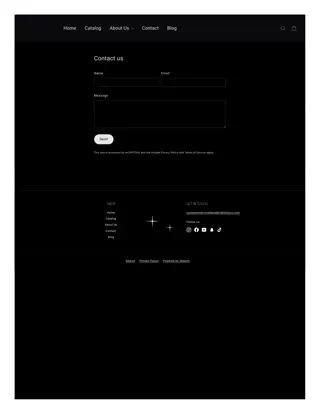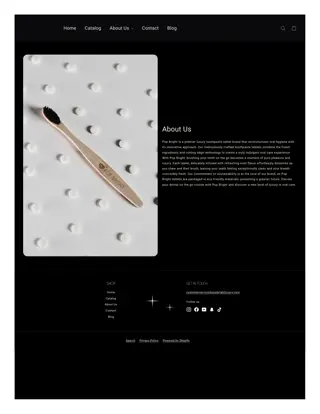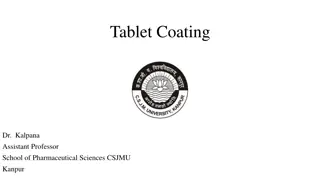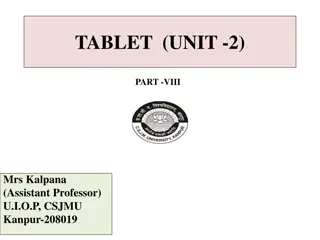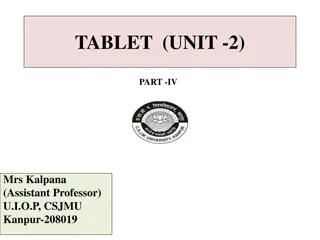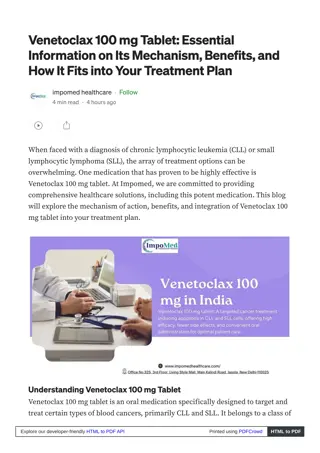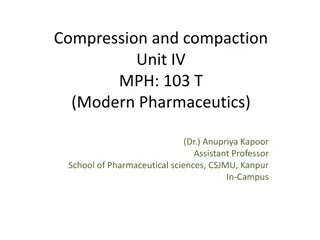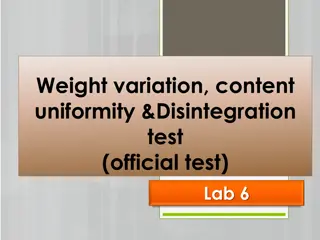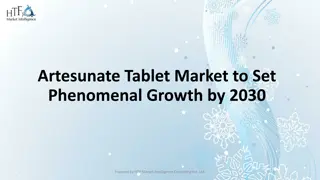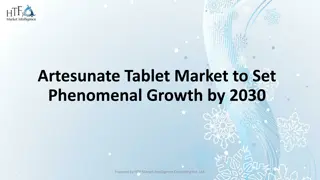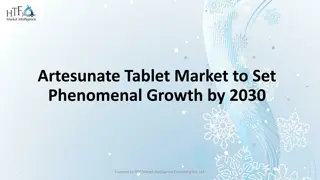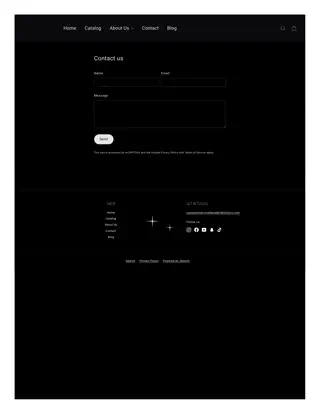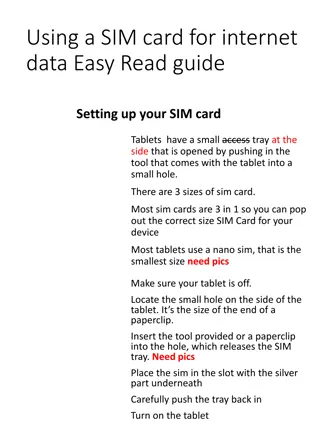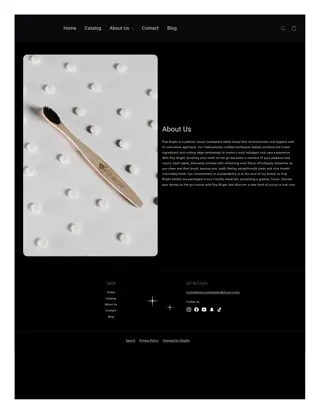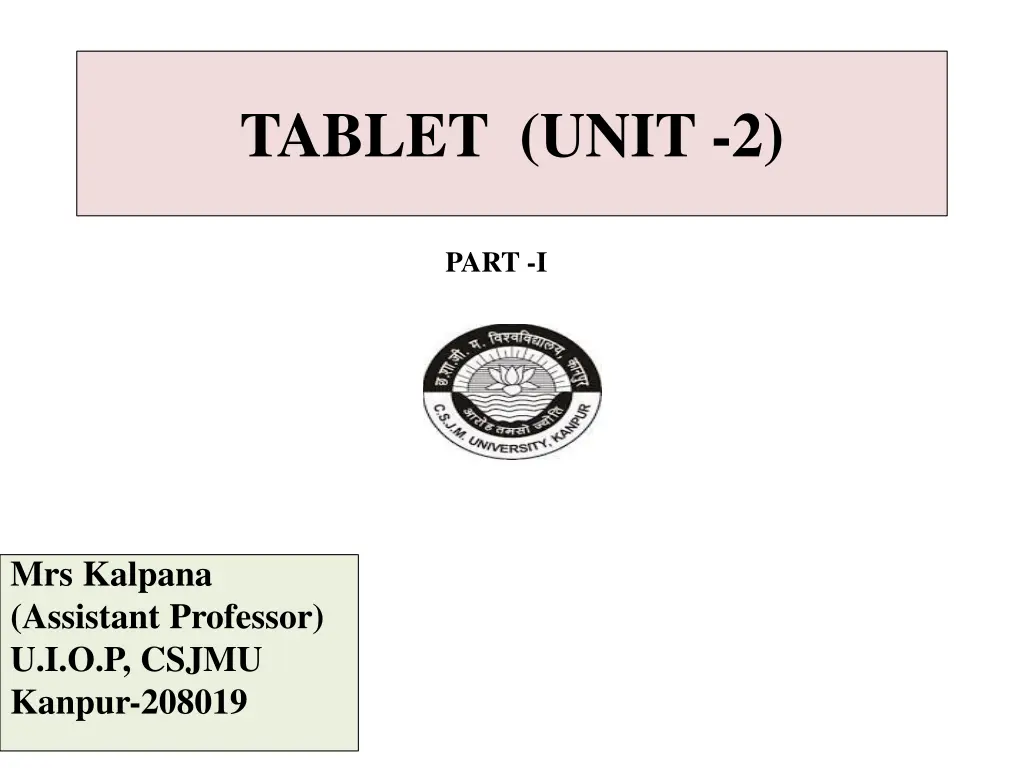
Tablet Additives and Components Explained
Learn about the various additives and components found in tablets, including diluents, binders/adhesives, disintegrants, and superdisintegrants. Discover the role these materials play in tablet formulation and their importance in producing high-quality tablets for effective drug delivery.
Download Presentation

Please find below an Image/Link to download the presentation.
The content on the website is provided AS IS for your information and personal use only. It may not be sold, licensed, or shared on other websites without obtaining consent from the author. If you encounter any issues during the download, it is possible that the publisher has removed the file from their server.
You are allowed to download the files provided on this website for personal or commercial use, subject to the condition that they are used lawfully. All files are the property of their respective owners.
The content on the website is provided AS IS for your information and personal use only. It may not be sold, licensed, or shared on other websites without obtaining consent from the author.
E N D
Presentation Transcript
TABLET (UNIT -2) PART -I Mrs Kalpana (Assistant Professor) U.I.O.P, CSJMU Kanpur-208019
Tablet Additives In tablet other than active ingredients it also contains a number of inert materials known as excipients or additives. Different excipients are: Diluent Binder or adhesive Disintegrents Main components of Tablet Lubricants and glidants Coloring agents Flavoring agents Sweetening agents
Diluents When the drug dosage itself is inadequate to produce the bulk than Diluents or fillers are used to make required bulk of the tablet Diluents also provide better tablet properties such as to permit the use of direct compression manufacturing process , improve cohesion and to promote flow. A diluents should have following properties: They must be non toxic They must be commercially available in acceptable grade. There cost must be low
They must be physiologically inert . They must be physically & chemically stable by themselves & with the drugs. They must be free from all microbial contamination.. They do not alter the bioavailability of drug. They must be color compatible. Eg: Commonly used tablet diluents Lactose-anhydrous Spray dried lactose Directly compressed starch-Sta Rx 1500 Hydrolyzed starch-Emdex &Celutab Microcrystalline cellulose-Avicel (PH 101and PH 102) Dibasic calcium phosphate dehydrate Calcium sulphate dihydrate Mannitol Sorbitol Sucrose- Sugartab, DiPac, Nutab 10. Dextrose
Binders and Adhesives These materials are used either in dry or wet- form to form granules or to form cohesive compacts for directly compressed tablet. Example : Acacia, tragacanth- Solution for 10-25% Conc. Cellulose derivatives- Methyl cellulose, HPC, HPMC Gelatin- 10-20% solution Glucose- 50% solution Polyvinylpyrrolidone (PVP)- 2% conc. Starch paste-10-20% solution Sodium alginate
Disintegrants Disintegrants are added to a tablet formulation to facilitate the breaking or disintegration of tablet or granules, when it comes in contact with water of GIT. Example Starch- 5-20% of tablet weight. Starch derivative Primogel and Explotab (1-8%) Clays- Veegum HV, bentonite 10% level in colored tablet only Cellulose derivatives- Ac- Di-Sol (sodium carboxy methyl cellulose) Alginate PVP (Polyvinylpyrrolidone), cross-linked
Superdisintegrants Superdisintegrants in tablet swells up to ten fold within 30 seconds as comes in contact of water. Example : Crosscarmellose- cross-linked cellulose, Crosspovidone- cross-linked povidone Sodium starch glycolate- cross-linked starch. These cross-linked products swell upto 10 fold with in 30 seconds as comes in contact of water stages of addition :A part of disintegrant is added before granulation and a part before compression, which serve as glidants or lubricant. Evaluation of carbon dioxide in effervescent tablets is also one way of disintegration
Lubricant and Glidants To prevent adhesion of the tablet materials to the surface of dies and punches lubricant is used. Glidants are used to promote flow of powder or granules material by reducing the friction between the particles. Example: Lubricants-, Stearic acid salt - Stearic acid, Stearic acid, Talc, Magnesium stearate,PEG (Polyethylene glycols), Surfactants Glidants-Silica derivative - Colloidal silica Corn Starch 5-10% conc., Talc-5% conc.,
Coloring agent The use of colors and dyes in a tablet has three purposes Product Identification Masking of off color drugs Production of more elegant product All coloring agents must be approved and certified by FDA. Two forms of colors are used in tablet preparation FD &C and D & C dyes. These dyes are applied as solution in the granulating agent or Lake form of these dyes. Lakes are dyes absorbed on hydrous oxide and employed as dry powder coloring. Example: FD & C yellow 6-sunset yellow ,FD & C yellow 5- Tartrazine , FD & C green 3- Fast Green ,FD & C blue 1- Brilliant Blue ,FD & C blue 2 - Indigo carmine D & C red 3- Erythrosine., D & C red 22 Eosin Y
Flavoring agents: For chewable tablet- oil flavours are used Sweetening agents For chewable tablets: Sugar, mannitol. Saccharine (artificial): 500 time s sweeter than sucrose Disadvantage: Bitter aftertaste and carcinogenic Aspartame (artificial) Disadvantage: Lack of stability in presence of moisture.

